Best Ways to Get Rid of Crickets Naturally
Crickets are a common problem for homeowners, especially during the summertime. These little pests can be very noisy and annoying, and they can also damage your property. In this blog post, we will discuss 9 natural ways to get rid of crickets. We will also go in-depth into why crickets are attracted to certain things, and how you can use this information to your advantage. Finally, we will provide detailed instructions on how to implement each of these methods. Let’s get started!
9 Natural Ways to Get Crickets out of Your Home:
- Reduce Light Sources
- Keep Windows and Doors Closed
- Use Yellow Bulb Porch Light
- Eliminate Food Sources
- Remove Potential Hiding Spots
- Use a Cricket Trap
- DIY Cricket Repellent
- Use Plants That Crickets Dislike
- Use Diatomaceous Earth
Now that you can see your options, let’s discuss each method in more detail. This way you know exactly how to implement these tips and choose the right method for you and your cricket problem.
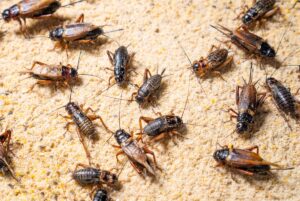
1. Reduce Light Sources
One of the things that crickets are attracted to is light. They are especially attracted to porch lights and other outdoor light sources. This is mainly because they are attracted to the insects that are also drawn to these light sources. To reduce the cricket population around your home, you will want to reduce the number of light sources that you have. One way to do this is to simply turn off your porch light when you are not using it. You may also want to turn off any pathway or garden lights that you have. If you have a light on your garage, it may also be attracting crickets. String lights are also a common attractant for crickets. If you have these around your home, you may want to consider removing them.
2. Keep Your Windows and Doors Closed
Another way to reduce the number of crickets in your home is to keep your windows and doors closed. This is especially important at night when crickets are most active. Crickets can easily squeeze through small cracks and openings, so it is important to make sure that your windows and doors are properly sealed.
Of course, many of us like a cool night breeze, so just make sure you have a good screen covering without any holes. This will allow you to keep your windows and doors open while still keeping the crickets out. The best types of screens for keeping bugs out are metal screens. If you happen to have doors, windows, or screens that are broken, you can easily repair them with a little bit of mesh and some glue. Just make sure the repair is secure so that no crickets can get in. Repairing windows and doors is a fairly easy construction project that almost anyone can do!

3. If You Have a Porch Light, Consider Switching It to a Yellow Bulb
As we mentioned before, crickets are attracted to light. This means that your porch light is likely attracting them to your home. If you have a porch light, consider switching it to a yellow bulb. Studies have shown that yellow bulbs are less attractive to insects than other colors of light.
Another option is to use a solar-powered LED light. These lights are just as effective as traditional porch lights, but they do not attract as many insects. This is because they do not emit as much light as conventional bulbs and they are not as warm. You can also find solar-powered lights that are specifically designed to repel insects.
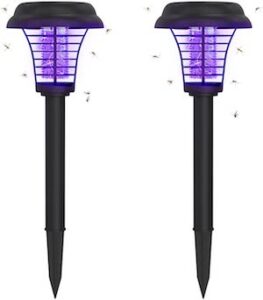
4. Eliminate Their Food Sources
One way to get rid of crickets is to eliminate their food sources. Crickets are mainly attracted to two things: food and moisture. If you can remove these things from your home, you will likely see a reduction in the cricket population.
One way to do this is to keep your food in airtight containers. This will prevent crickets from getting to it. You should also make sure that you do not have any open food sources, such as pet food or bird seed. If you have a garden, make sure to keep it free of fallen fruit.
Another way to eliminate their food sources is to remove any moisture sources. This means fixing any leaks in your home, such as dripping faucets or leaking pipes. You should also make sure that you do not have any standing water, such as in a clogged sink or a rain gutter. If you have a pet, make sure to empty their water bowl at night so that it does not attract crickets. If you have a swimming pool, you will also want to make sure that it is properly covered so that crickets cannot get in.
The most common food sources for crickets include:
- Fruits and Vegetables
- Starchy Foods (such as Bread and Pasta)
- Meats
- Sugary Foods (such as Candy and Cake)
5. Remove Potential Hiding Spots
Crickets like to hide in dark, humid places. To reduce the number of crickets in your home, you will want to remove potential hiding spots. One way to do this is to clear out any clutter that you have around your home. This includes things like boxes, newspapers, and clothing that is lying on the floor.
You should also check for cracks and crevices where crickets could be hiding. These include cracks in the foundation, around windows and doors, and in any storage areas. If you find any potential hiding spots, you may need to take up a simple construction project to fix them.
As far as outdoor hiding spots, you can remove potential hiding spots by trimming back any bushes or trees that are close to your home. You should also remove any piles of leaves, wood, or debris.
6. Use a Cricket Trap
If you are looking for a more effective way to get rid of crickets, you may want to consider using a cricket trap. There are many different types of cricket traps on the market, so be sure to choose one that is right for you.
One type of cricket trap is the glue board trap. This type of trap uses an adhesive board to capture crickets. The crickets become stuck to the board and cannot escape. Another type of cricket trap is the pheromone trap. This type of trap uses a pheromone to attract crickets. The crickets then enter the trap and are unable to get out.
While this isn’t a preventative method, it is still natural and safe as it uses things that are already found in nature and doesn’t include chemicals. You can easily make a cricket trap yourself for an easy and fun weekend construction project! It is better to try a method that prevents crickets from coming in the first place before having to use traps.
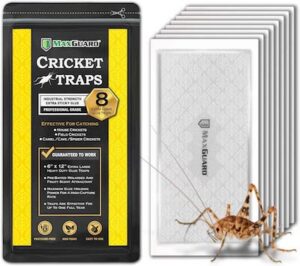
7. Homemade Cricket Repellent
If you want to avoid using chemicals in your home, you may be interested in making a homemade cricket repellent. There are many different recipes for homemade cricket repellents, so be sure to choose one that is right for you. These are the two most common homemade cricket repellents that you can make with items you likely already have.
- One popular recipe is made with essential oils. This includes things like peppermint oil, lemon grass oil, and eucalyptus oil. Simply mix these oils together and spray them around your home.
- Another popular recipe is made with vinegar and water. All you need to do is mix equal parts vinegar and water and spray it around your home. The vinegar will act as a natural repellent and will help to keep crickets away.
A homemade cricket repellent is especially helpful if you are trying to keep them out of your garden without harming your plants. These types of natural repellent should keep crickets away for an extended period of time and will not harm your plants or gardens in any way.
8. Plant Cricket-Repelling Plants
If you are looking for the most natural way to get rid of crickets, you may want to consider planting cricket-repelling plants. Not only are they beautiful, but they also serve the awesome purpose of helping you get rid of those pesky crickets! A few of these plants include:
- Marigolds
- Lemongrass
- Geraniums
- Peppermint
- Catnip
- Garlic
These plants release a natural scent that crickets do not like. By planting these around your home, you can help to keep crickets away. You can also put these plants in pots and place them around your home for an extra layer of protection. If you have a garden, planting these plants can also help to keep crickets away from your plants. This is a great way to get rid of crickets without harming your plants in any way.
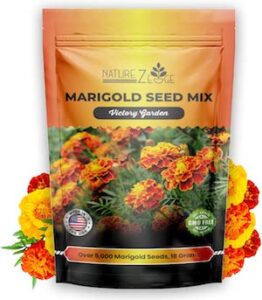
9. Use Diatomaceous Earth
Similar to the plants above, another natural method is using diatomaceous earth. Diatomaceous earth is a powder made from the fossilized remains of algae. It is often used as an insecticide and can be effective at repelling and killing crickets. It works by drying out the cricket’s exoskeleton, which ultimately kills them.
Diatomaceous earth is a natural and safe way to get rid of crickets. It is also relatively inexpensive and can be found at most hardware stores. Be sure to choose food-grade diatomaceous earth for this project as it is the safest type to use.
To use diatomaceous earth, simply sprinkle it around your home. You can also make a spray with water and diatomaceous earth. Be sure to wear a mask when using this product, as it can be harmful if inhaled in large quantities.
Once the crickets have encountered diatomaceous earth, they will likely die within 24 hours. After which, you will be able to vacuum them up and dispose of them. If you have a party or guests coming soon, this is a very quick and efficient way to get rid of crickets in your home or yard.
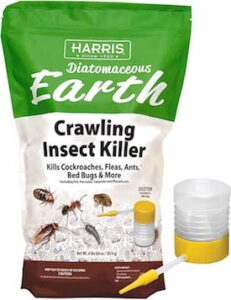
Related Questions
What do crickets eat?
Crickets are omnivorous, meaning they will eat both plants and animals. In the wild, they typically eat things like leaves, fruits, and other insects. If they are living in your home, they may also eat things like fabric and paper.
What do crickets need to survive?
Crickets need a few things to survive. They need food, water, and shelter. They also need a suitable temperature. Most crickets prefer warm climates and will die if the temperature gets too cold.
What is the life cycle of a cricket?
The life cycle of a cricket typically consists of four stages: egg, nymph, adult, and senescent. Crickets go through molting during each stage, shedding their exoskeleton as they grow. The entire process can take anywhere from two weeks to two months, depending on the species of cricket.
Can crickets harm humans?
Crickets generally do not pose a threat to humans. However, they can be carriers of disease and should be removed from your home if they are present.
Final Thoughts
In conclusion, there are many different natural ways to get rid of crickets. Whether you decide to use a trap, repellent, or plant, be sure to choose a method that is right for you. We are sure that one of these 9 methods will work for you! However, if you are concerned that you may have a cricket infestation, we recommend calling a pest control professional. They will be able to help you identify the problem and get rid of the crickets for good!
While there are many different ways to get rid of crickets, these are some of the most effective and natural methods. Be sure to try out a few different methods to see which one works best for you. Remember, getting rid of crickets can be a process, so be patient and consistent with your chosen method.
As always, thanks for reading! We hope this article helped you learn more about getting rid of crickets.
